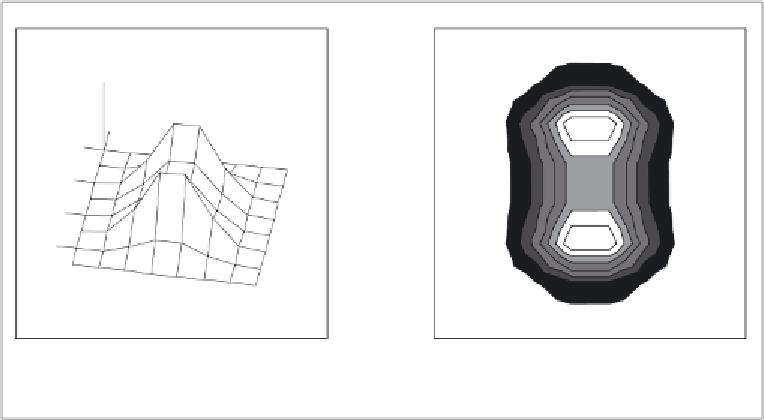Image Processing Reference
In-Depth Information
By swapping the Sobel templates, the measured edge direction can be arranged to be
normal to the edge itself (as opposed to tangential data along the edge). This is illustrated
in Figures
4.13
(c) and (d) for swapped versions of the templates given in Figures
4.10
and
4.12
, respectively. The rearrangement can lead to simplicity in algorithm construction
when finding shapes, to be shown later. Any algorithm which uses edge direction for
finding shapes must know precisely which arrangement has been used, since the edge
direction can be used to speed algorithm performance, but it must map precisely to the
expected image data if used in that way.
Detecting edges by
template convolution
again has a frequency domain interpretation.
The Fourier transform of a 7 × 7 Sobel template of Code
4.7
is given in Figure
4.14
. The
Fourier transform is given in relief in Figure
4.14
(a) and as a contour plot in Figure
4.14
(b). The template is for the horizontal differencing action,
My
, which highlights vertical
change. Accordingly, its transform reveals that it selects vertical spatial frequencies, whilst
smoothing the horizontal ones. The horizontal frequencies are selected from a region near
the origin (
low-pass
filtering), whereas the vertical frequencies are selected away from the
origin (
high-pass
). This highlights the action of the Sobel operator; combining smoothing
of the spatial frequencies along one axis with differencing of the other. In Figure
4.14
, the
smoothing is of horizontal spatial frequencies whilst the differencing is of vertical spatial
frequencies.
0
2
4
0
6
2
4
6
T
| Fourier_of_Sobel |
| Fourier_of_Sobel |
(a) Relief plot
(b) Contour plot
Figure 4.14
Fourier transform of the Sobel operator
4.2.5
The Canny edge detector
The
Canny edge detection operator
(Canny, 1986) is perhaps the most popular edge detection
technique at present. It was formulated with three main objectives:
1.
optimal
detection with no spurious responses;






















